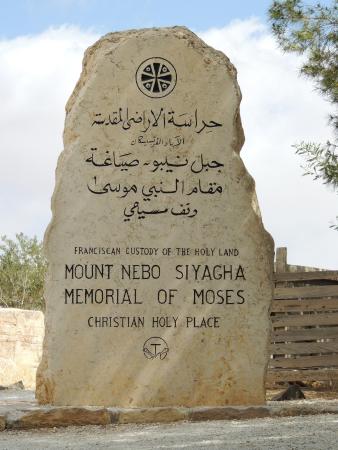Mount Nebo



Mount Nebo is an elevated ridge in Jordan, approximately 817 metres (2,680 ft) above sea level, mentioned in the Hebrew Bible as the place where Moses was granted a view of the Promised Land. The view from the summit provides a panorama of the Holy Land and, to the north, a more limited one of the valley of the River Jordan. The West Bank city of Jericho is usually visible from the summit, as is Jerusalem on a very clear day.
Religious significance
According to the final chapter of the Book of Deuteronomy, Moses ascended Mount Nebo to view the Land of Israel, which God had said he would not enter, and to die there; he was buried in an unknown valley location in Moab.
According to Christian tradition, Moses was buried on the mountain, although his place of burial is not specified.(Deuteronomy 34:6) Some Islamic traditions also stated the same, although there is a grave of Moses located at Maqam El-Nabi Musa, 11 km (6.8 mi) south of Jericho and 20 km (12 mi) east of Jerusalem in the Judean wilderness. Scholars continue to dispute whether the mountain currently known as Nebo is the same as the mountain referred to in Deuteronomy.
According to 2 Maccabees, (2:4–7), the prophet Jeremiah hid the tabernacle and the Ark of the Covenant in a cave there.
On March 19, 2000, Pope John Paul II visited the site during his pilgrimage to the Holy Land. During his visit he planted an olive tree beside the Byzantine chapel as a symbol of peace. Pope Benedict XVI visited the site in 2009, gave a speech, and looked out from the top of the mountain in the direction of Jerusalem.
A serpentine cross sculpture (the Brazen Serpent Monument) atop Mount Nebo was created by Italian artist Giovanni Fantoni. It is symbolic of the bronze serpent created by Moses in the wilderness (Numbers 21:4–9) and the cross upon which Jesus was crucified (John 3:14).
Archaeology
On the highest point of the mountain, Syagha, the remains of a Byzantine church and monastery were discovered in 1933.[8] The church was first constructed in the second half of the 4th century to commemorate the place of Moses’ death. The church design follows a typical basilica pattern. It was enlarged in the late fifth century A.D. and rebuilt in A.D. 597. The church is first mentioned in an account of a pilgrimage made by a lady Aetheria in A.D. 394. Six tombs have been found hollowed from the natural rock beneath the mosaic-covered floor of the church. In the modern chapel presbytery, built to protect the site and provide worship space, remnants of mosaic floors from different periods can be seen. The earliest of these is a panel with a braided cross presently placed on the east end of the south wall.
The Moses Memorial that houses the Byzantine mosaics has been closed for renovation from 2007 to 2016. It reopened on 15 October 2016.
Source : wikipedia
Reviews
Opening Hours: daily from 7.00h till 19.00h in summer and 17.00h in winter time
Entrance Fee: 1 JD
Getting here
The site is about 10 minutes west of Madaba by car (cca 8 kms) and around 26 kms away from Amman.


Rate this article